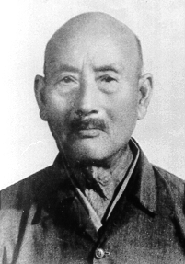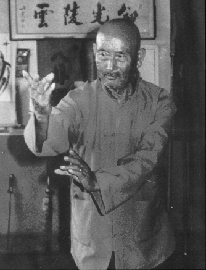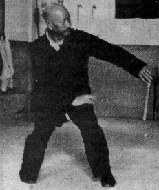 |
 |
 |
[ Go to Bottom ]
-
 |
 |
 |
[ Go to Bottom ]
*** Welcome ***
to the Ba Gua Zhang (Pa Kua Chang) Website of Sifu Park Bok-Nam!
We hope that you will find this site to be interesting and informative,
and will use it as a starting point
for learning more about the Ba Gua Zhang of Lu Shui-Tian.
|
= THIS EDITION = Featured in this edition of the FYI Page: METHOD OF LU SHUI-TIAN .. |
|
. by Master Bok-Nam Park, with Francis Hriadil . is now out in the August 2000/Vol. 27, No. 8 Issue of "Inside Kung Fu" (United States) which is published by C.F.W. Enterprises.
|
. by Master Bok-Nam Park and Francis Hriadil . is now out in Issue 49 - May/June 2000 of "Qi Magazine" (United Kingdom) which is published by the Tse Qigong Centre.
|
|
|
|
|
|
|
Ba Gua Zhang Method of Lu Shui-Tian. The information provided here is based on the personal recollections of Park Bok-Nam and research that has been carried out into the life and background of Lu Shui-Tian. |
|
as Taught byPark Bok-Nam," by Park Bok-Nam and Dan Miller, published by High View Publications in 1993. This book, along with its companion video and follow-on volume, are currently available here and from all prominent martial arts bookstores and mail order catalogs. ] |
|
METHOD OF LU SHUI-TIAN Bok-Nam Park [Adapted and re-edited by F. Hriadil] |
| Lu Shui-Tian (1894 - 1978) was born in the town of Ching Tao, which is located in Shantung Province. When he was young, Lu Shui-Tian studied the "farmer style" martial arts that were prevalent in his village at that time. The term "farmer style" refers to the various "family style" martial arts that were practiced in the remote towns and villages scattered throughout China. Because there was no police protection throughout much of China's history, a village would often hire an experienced martial artist to live there for a time and teach the young men the skills of fighting. Once a group was sufficiently trained, the martial artist would move on and the initial group would continue to train others in the village. Over time, the original system that was taught would evolve and change, and the village or town would make the art their own. |
 Lu Shui-Tian |
| After practicing the "farmer
style" for a number of years, Lu wanted to learn
more. He had heard that the best of the fighting
arts being practiced in China was Ba Gua Zhang (Pa
Kua Chang). So, when he was still a teenager
he began to search the countryside for a Ba Gua Zhang
instructor.
The teacher that Lu Shui-Tian found was Li Qing-Wu (Li Ching-Wu). Li Qing-Wu (1864 - ?) lived in a town north of Ching Tao which was about a two day ride away by horse. Lu Shui-Tian would frequently make the journey to Li's village to train with him, and would remain there for months, and even years at a time. Studying and practicing Ba Gua Zhang became the whole focus of his life. |
| Not much is known about Li
Qing-Wu. And so far, no one has been able to
determine who his teacher was. This is an area of
ongoing research. Lu Shui-Tian did tell Master
Park that
Li Qing-Wu
was not part of the well-recognized and
What is also known is that Li Qing-Wu was so selective about who he taught that he only had ten Ba Gua Zhang students throughout his entire life. Li taught each student individually and felt that ten students was all that he could handle. Because Li and his students kept to themselves, his Ba Gua Zhang did not spread very far. Also, Li and his students were so secretive that Li once severely reprimanded Lu Shui-Tian for bringing a Xing Yi Quan acquaintance to meet him without first asking his permission. |
| Most of Li Qing-Wu's students did not come from his home village. So like Lu Shui-Tian, they had to travel to Li's village to study with him. They would train for a while and then return to their own towns and villages to practice what they had learned. Based on the student's body type and aptitude, Li would teach each student the one aspect of the art to specialize in that suited him best. After Li was certain that the student had reached a certain level of proficiency in what had been taught, the student would be sent back to his home to practice for a year before returning for more instruction. |
| Periodically, Li Qing-Wu would
invite all ten of his disciples to his home to train
together. At these gatherings, he would have each
student teach all of the other students those aspects of
the art that they had specialized in. He would
oversee their practice and would instruct each student
on what aspects of the art they needed to focus on next.
Li Qing-Wu
felt that it was extremely important for his
students to |
| When Lu Shui-Tian went to visit his teacher, he would be immediately tested on his Ba Gua Zhang skills. Li would then tell him what he needed to work on more or work on next. Li would teach him new material as necessary and Lu would practice it for several months. Lu Shui-Tian would then be tested again before returning home. Before leaving, Li would tell him what areas he needed to practice at home until the next time they would meet. |
|
other Ba Gua Zhang instructors. |
| It is known that Lu Shui-Tian spent some time with a practitioner from Dong Hai-Chuan's lineage. Lu Shui-Tian seldom spoke of his background. Whenever Master Park happened to ask a question that related to Lu's background, Lu Shui-Tian would always respond "That question will not help your practice." Since Master Park knew that Lu Shui-Tian's Ba Gua Zhang was very good, he was not particularly concerned about where his Ba Gua Zhang had come from and did not press the question. Unfortunately in 1978, Lu Shui-Tian died in a tragic accident, when he was overcome in his sleep by a malfunctioning gas heater, before his early history was completely revealed. |
 Lu Shui-Tian in the Giraffe Posture |
| Master Park assumes that his teacher, Lu Shui-Tian, shared his Ba Gua Zhang knowledge with many of his martial arts contemporaries, as Lu traveled widely and enjoyed visiting other martial artists wherever he went. |
|
utilized his Ba Gua Zhang fighting skills during the Sino-Japanese War (1931-1945) as a member of a band of expert guerrilla fighters. |
| Lu Shui-Tian killed many Japanese soldiers. He and his band of Chinese martial artists would hide in the mountains during the day and infiltrate Japanese encompments at night. Because their operations had to remain covert, the group had to kill the enemy without the use of firearms. Only traditional bare hand techniques and weapons techniques were utilized since it enabled the guerrillas to move in and out of the Japanese camps without being noticed. |
 Lu Shui-Tian performing Open the Shutters to Look at the Moon |
Eventually, Lu Shui-Tian became so well known for his fighting skill that the Japanese put a price on his head, forcing him to seek safe haven for himself and his family in Inchon, Korea. Lu and his wife would venture back into China repeatedly to carry on the fight. However, after his wife was killed on one such incursion, Lu never returned to China again. He remained in the Chinatown community of Inchon for the rest of his life, where he began teaching his Ba Gua Zhang method and eventually took on Park Bok-Nam as his student. |
|
|
| They know he was from the village
of Ching Tao and they know that he left the country
during the Sino-Japanese War. Several Yin Fu style
practitioners stated that they believed Lu Shui-Tian's
second teacher was Lou Shou-Kui, who is known to have
studied under He Jing-Kui, the son-in-law and student of
Yin Fu. This connection has never been
conclusively verified; but, it does make sense to some,
since elements of the Ba Gua Zhang method of Lu
Shui-Tian are characteristic of the Yin Fu style*.
A stele** was erected at the memorial burial site of
Dong Hai-Chuan in Beijing, China in June of 1991
acknowledging the spread of Ba Gua Zhang into Korea by
Lu Shui-Tian. [Editor's Note: * 9.25.2019 - Master Park recently updated and clarified the Dong Hai-Chuan connection, based on additional information that Lu Shui-Tian personally told him, before Lu Shui-Tian passed away. This can be found on Master Park's bio page, Park Bok-Nam . ** Pictures of the stele in Beijing can also be seen on Master Park's bio page, Park Bok-Nam .] |
| Though only peripherally connected to the Dong Hai-Chuan lineage, Lu Shui-Tian told Master Park that his first teacher, Li Qing-Wu, taught a more complete and comprehensive method than his later teacher because it combined both straight line methods and directional footwork with circle walking forms and maneuvers. He further mentioned that the method of his second instructor only contained practice that was based on circle walking. |
|
the training he received under Li Qing-Wu. |
|
|
| In keeping with the tradition and views of Lu Shui-Tian, Master Park does not place much emphasis on the lineage of his Ba Gua Zhang method other than to acknowledge what is known and what is not known. |
| Master Park often tells his
students that
knowledge of
lineage, while of some historical value, does
little It is more important to study the principles upon which the art is based and to carry out the training that the art demands. |
=== Suggestions to improve this site are always welcome ===
Submit any comments, suggestions, etc. to E-Mail:
[ Go to Top ]
 |
 |
 |